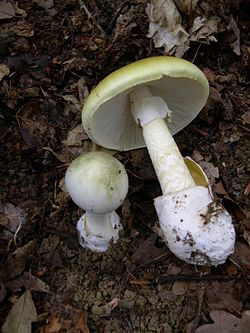Mushroom poisoning

Editor-In-Chief: Prab R Tumpati, MD
Obesity, Sleep & Internal medicine
Founder, WikiMD Wellnesspedia &
W8MD medical weight loss NYC and sleep center NYC
| Mushroom poisoning | |
|---|---|

| |
| Synonyms | N/A |
| Pronounce | N/A |
| Specialty | N/A |
| Symptoms | Nausea, vomiting, abdominal pain, diarrhea, liver failure, kidney failure |
| Complications | Liver failure, kidney failure, death |
| Onset | Typically 6-12 hours after ingestion |
| Duration | Varies depending on the type of mushroom and treatment |
| Types | Amatoxin poisoning, Gyromitrin poisoning, Orellanine poisoning, Muscarine poisoning, Psilocybin poisoning |
| Causes | Ingestion of toxic mushrooms |
| Risks | Foraging for wild mushrooms without proper knowledge |
| Diagnosis | Based on history of ingestion, symptoms, and identification of mushroom |
| Differential diagnosis | Gastroenteritis, food poisoning, viral hepatitis |
| Prevention | Avoiding consumption of wild mushrooms unless identified by an expert |
| Treatment | Activated charcoal, gastric lavage, supportive care, liver transplant in severe cases |
| Medication | N/A |
| Prognosis | Varies; can be fatal if not treated promptly |
| Frequency | Unknown; varies by region and foraging habits |
| Deaths | N/A |
Heading text[edit]

Mushroom poisoning refers to harmful effects from ingestion of toxic substances present in a mushroom. These toxins can pose serious health risks and in some cases, can be fatal.
Symptoms[edit]
The symptoms of mushroom poisoning can vary, depending on the specific toxin involved. They can range from mild gastrointestinal discomfort to severe, life-threatening organ failure. Symptoms can include nausea, vomiting, diarrhea, abdominal pain, dizziness, hallucinations, and in severe cases, coma or death.
Causes[edit]
Mushroom poisoning is caused by the consumption of raw or cooked fruiting bodies (mushrooms, toadstools) of a number of species of higher fungi. The term toadstool (from the German Todesstuhl, death's stool) is commonly given to poisonous mushrooms, but for individuals not expert in mushroom identification, differentiation between edible and poisonous fungi is not possible based on macroscopic morphology alone.
Treatment[edit]
Treatment for mushroom poisoning depends on the specific toxin that has been ingested. In some cases, the patient may need to be hospitalized and given supportive care, such as fluids and medications to control symptoms. In severe cases, the patient may need a liver transplant.
Prevention[edit]
Prevention of mushroom poisoning is best achieved by only consuming wild mushrooms that have been identified by a skilled mycologist. In addition, it is recommended to only eat wild mushrooms that are known to be safe and to avoid those that are potentially toxic.
See also[edit]
Ad. Transform your life with W8MD's Budget GLP-1 injections from $75


W8MD offers a medical weight loss program to lose weight in Philadelphia. Our physician-supervised medical weight loss provides:
- Weight loss injections in NYC (generic and brand names):
- Zepbound / Mounjaro, Wegovy / Ozempic, Saxenda
- Most insurances accepted or discounted self-pay rates. We will obtain insurance prior authorizations if needed.
- Generic GLP1 weight loss injections from $75 for the starting dose.
- Also offer prescription weight loss medications including Phentermine, Qsymia, Diethylpropion, Contrave etc.
NYC weight loss doctor appointmentsNYC weight loss doctor appointments
Start your NYC weight loss journey today at our NYC medical weight loss and Philadelphia medical weight loss clinics.
- Call 718-946-5500 to lose weight in NYC or for medical weight loss in Philadelphia 215-676-2334.
- Tags:NYC medical weight loss, Philadelphia lose weight Zepbound NYC, Budget GLP1 weight loss injections, Wegovy Philadelphia, Wegovy NYC, Philadelphia medical weight loss, Brookly weight loss and Wegovy NYC
|
WikiMD's Wellness Encyclopedia |
| Let Food Be Thy Medicine Medicine Thy Food - Hippocrates |
Medical Disclaimer: WikiMD is not a substitute for professional medical advice. The information on WikiMD is provided as an information resource only, may be incorrect, outdated or misleading, and is not to be used or relied on for any diagnostic or treatment purposes. Please consult your health care provider before making any healthcare decisions or for guidance about a specific medical condition. WikiMD expressly disclaims responsibility, and shall have no liability, for any damages, loss, injury, or liability whatsoever suffered as a result of your reliance on the information contained in this site. By visiting this site you agree to the foregoing terms and conditions, which may from time to time be changed or supplemented by WikiMD. If you do not agree to the foregoing terms and conditions, you should not enter or use this site. See full disclaimer.
Credits:Most images are courtesy of Wikimedia commons, and templates, categories Wikipedia, licensed under CC BY SA or similar.
Translate this page: - East Asian
中文,
日本,
한국어,
South Asian
हिन्दी,
தமிழ்,
తెలుగు,
Urdu,
ಕನ್ನಡ,
Southeast Asian
Indonesian,
Vietnamese,
Thai,
မြန်မာဘာသာ,
বাংলা
European
español,
Deutsch,
français,
Greek,
português do Brasil,
polski,
română,
русский,
Nederlands,
norsk,
svenska,
suomi,
Italian
Middle Eastern & African
عربى,
Turkish,
Persian,
Hebrew,
Afrikaans,
isiZulu,
Kiswahili,
Other
Bulgarian,
Hungarian,
Czech,
Swedish,
മലയാളം,
मराठी,
ਪੰਜਾਬੀ,
ગુજરાતી,
Portuguese,
Ukrainian


